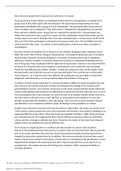Describe and evalua Study guides, Class notes & Summaries
Looking for the best study guides, study notes and summaries about Describe and evalua? On this page you'll find 141 study documents about Describe and evalua.
All 141 results
Sort by
Describe and evaluate Asch's research into conformity. (16 marks)
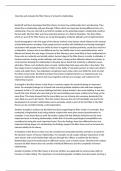
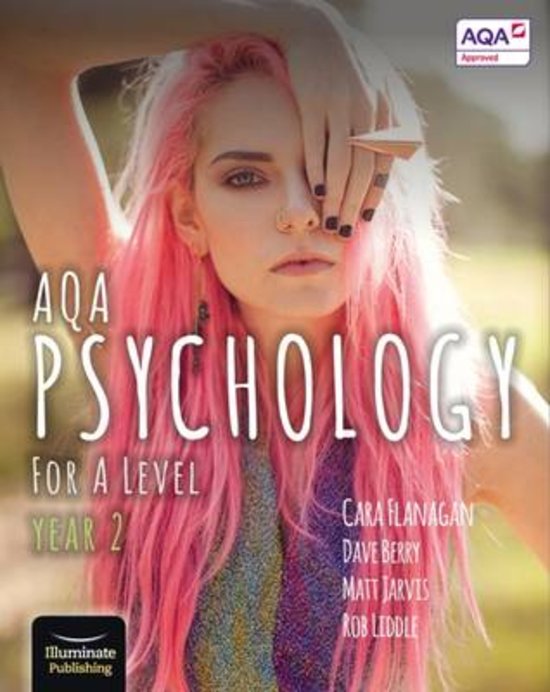
-
Describe and evaluate the filter theory of romantic relationships.
- Essay • 2 pages • 2023
- Available in package deal
-
- $6.93
- + learn more
Full 16 marker essay on the Filter theory of romantic relationships. Describe and evaluate the filter theory of romantic relationships. (16 mark)


-
Describe and evaluate research into virtual relationships in social media
- Essay • 1 pages • 2023
- Available in package deal
-
- $7.85
- + learn more
Full 16 marker essay for psychology, Aqa Alevel. Describe and evaluate research into virtual relationships in social media (16 marks). You can break this essay down to also answer 4,6,8 markers etc aswell.
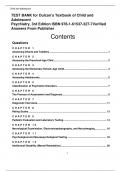
-
TEST BANK for Dulcan's Textbook of Child and Adolescent Psychiatry, 3rd Edition ISBN 978-1-61537-327-7 Verified Answers From Publisher
- Exam (elaborations) • 381 pages • 2023
-
- $16.59
- 12x sold
- + learn more
TEST BANK for Dulcan's Textbook of Child and Adolescent Psychiatry, 3rd Edition ISBN 978-1-61537-327-7 Verified Answers From Publisher Contents Questions C H A P T E R 1 Assessing Infants and Toddlers 1 C H A P T E R 2 Assessing the Preschool-Age Child 2 C H A P T E R 3 Assessing the Elementary School–Age Child 4 C H A P T E R 4 Assessing Adolescents 5 C H A P T E R 5 Classification of Psychiatric Disorders 7 C H A P T E R 6 The Process of Assessment and Diagnosis 9 C H A P T ...
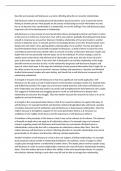
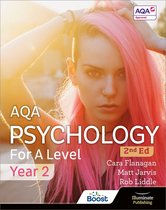
-
Describe and evaluate self-disclosure as a factor affecting attraction in romantic relationships.
- Essay • 1 pages • 2023
- Available in package deal
-
- $6.93
- + learn more
Full 16 mark essay. Describe and evaluate self-disclosure as a factor affecting attraction in romantic relationships?
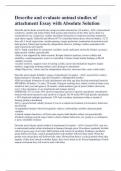
-
Describe and evaluate animal studies of attachment Essay with Absolute Solution
- Essay • 4 pages • 2024
-
- $9.99
- + learn more
Describe and evaluate animal studies of attachment Essay with Absolute Solution Describe and evaluate research into caregiver-infant interactions (16 marks) - AO1= interactional synchrony- mother and infant reflect both actions and emotions of the other and is done in a synchronised way, reciprocity- mother and infant interaction is reciprocal and they respond to each others signals. Meltzoff and Moore(1977)= controlled observation, observed babies, 12-27 days old, 3 facial expressions- mouth...
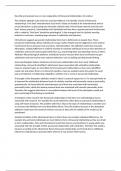
-
Describe and evaluate one or more explanation of Parasocial relationships. (16 marks.)
- Essay • 1 pages • 2023
- Available in package deal
-
- $6.93
- + learn more
Full 16 marker essay, all you need for the aqa exam alevel. Describe and evaluate one or more explanation of Parasocial relationships. (16 marks.)
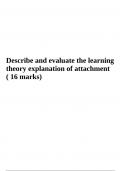
-
Describe and evaluate the learning theory explanation of attachment ( 16 marks)
- Exam (elaborations) • 2 pages • 2023
-
- $13.49
- + learn more
Describe and evaluate the learning theory explanation of attachment ( 16 marks) There are Two main types of learning behaviour which are Classical conditioning (learning through association) and Operant conditioning (learning through consequences). Attachment develops because of classical and/or operant. DOLLARD AND MILLER (1950) suggested the learning theory. Learning theory suggests that attachment is a learned behaviour. They develop through experience via: association (classical conditi...
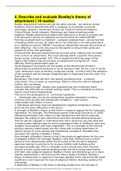
-
4. Describe and evaluate Bowlby's theory of attachment ( 16 marks)
- Exam (elaborations) • 3 pages • 2023
-
- $8.49
- + learn more
4. Describe and evaluate Bowlby's theory of attachment ( 16 marks) Bowlby argued that humans are just like other animals – we need an innate tendency to form attachments with a caregiver as it provides a survival advantage. Bowlby’s monotropic theory has 5 distinct elements:Adaptive , Critical Period, Social releasers ,Monotropy and Internal working model. Adaptive: Bowlby believed that Attachment behaviour is innate & evolved over time because it serves an important survival function for...
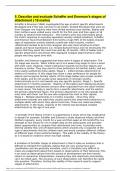
-
5. Describe and evaluate Schaffer and Emerson's stages of attachment ( 16 marks)
- Exam (elaborations) • 4 pages • 2024
-
- $10.48
- + learn more
5. Describe and evaluate Schaffer and Emerson's stages of attachment ( 16 marks) Schaffer & Emerson (1964) investigated the age at which specific attachments developed and if this was common to all infants. Studied 60 babies that were all from Glasgow, the majority were from skilled working class families. Babies and their mothers were visited every month for the first year and then again at 18 months to observe their behaviour . The mothers were also interviewed about the child’s response ...

